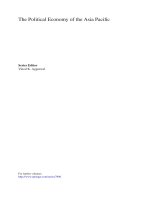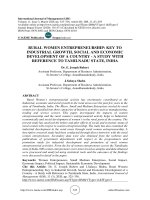Economic growth and economic development 371
Bạn đang xem bản rút gọn của tài liệu. Xem và tải ngay bản đầy đủ của tài liệu tại đây (112.97 KB, 1 trang )
Introduction to Modern Economic Growth
Armed with these theorems, we can now investigate the transitional dynamics in
the q-theory of investment. To see that the equilibrium will tend to this steady-state
level of capital stock it suffices to plot (7.59) and (7.62) in the k-i space. This is done
in Figure ??. The curve corresponding to k˙ = 0, (7.59), is upward sloping, since a
greater level of capital stock requires more investment to replenish the depreciated
capital. When we are above this curve, there is more investment than necessary
for replenishment, so that k˙ > 0. When we are below this curve, then k˙ < 0. On
the other hand, the curve corresponding to i˙ = 0, (7.62), can be nonmonotonic.
Nevertheless, it is straightforward to verify that in the neighborhood of the steadystate it is downward sloping (see Exercise 7.22). When we are to the right of this
curve, f 0 (k) is lower, thus i˙ > 0. When we are to its left, i˙ < 0. The resulting phase
diagram, together with the one-dimensional stable manifold, is shown in Figure ??
(see again Exercise 7.22 for a different proof).
Starting with an arbitrary level of capital stock, k (0) > 0, the unique optimal
solution involves an initial level of investment i (0) > 0, followed by a smooth and
monotonic approach to the steady-state investment level of δk∗ . In particular, it
can be shown easily that when k (0) < k∗ , i (0) > i∗ and it monotonically decreases
towards i∗ (see Exercise 7.22). This is intuitive. Adjustment costs discourage large
values of investment, thus the firm cannot adjust its capital stock to its steady-state
level immediately. However, because of diminishing returns, the benefit of increasing
the capital stock is greater when the level of capital stock is low. Therefore, at the
beginning the firm is willing to incur greater adjustment costs in order to increase
its capital stock and i (0) is high. As capital accumulates and k (t) > k (0), the
benefit of boosting the capital stock declines and the firm also reduces investment
towards the steady-state investment level.
It is also informative to see why a level of initial investment other than i (0) would
violate either the transversality condition or the first-order necessary conditions.
Consider, for example, i0 (0) > i (0) as the initial level. The phase diagram in
Figure ?? makes it clear that starting from such a level of investment, i (t) and
k (t) would tend to infinity. It can be verified that in this case q (t) k (t) would
tend to infinity at a rate faster than r, thus violating the transversality condition,
limt→∞ exp (−rt) q (t) k (t) = 0. To see this more explicitly, note that since along a
357









